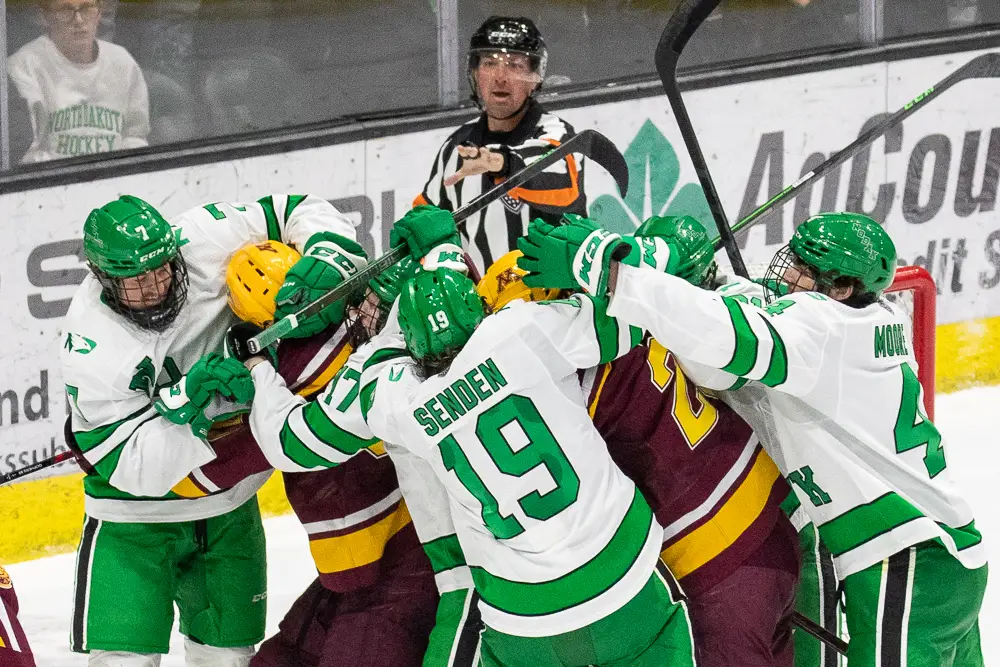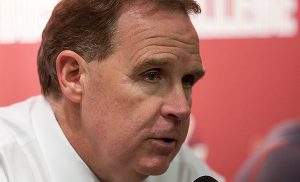
The first half of college hockey’s 2021-22 season brought about the return of familiar surroundings.
Fans lost during a year of empty arenas once again filed through turnstiles and ticket booths in order to cheer their teams, and chants dating back decades rang through campuses across the United States. The pageantry of the sport, once stripped to its component parts, was simply back, and life injected new energy into the players and coaches who navigated the bridge between the new normal and the bygone era before COVID-19.
There were signs everywhere that returning to arenas didn’t necessarily translate to the reality lost when COVID descended on American society. From a literal sense, colleges had to grapple with a disorganized nation unsure of how to require vaccinations or negative test results in order to attend a sporting event. Beyond that, the very footprint of the game shifted into a digital universe, one that now seeks to deliver content to fans in a blended capacity with when they both are and aren’t in arenas.
The digital world’s use exploded in the COVID world after the pandemic forced the shutdown of most social areas of society. The very notion of bringing groups of people under one roof was antithetical to the social distancing measures required before vaccines were available, but as people sought to socialize and communicate, virtual environments brought them together as best as possible.
The hours once spent in person transitioned to a more online world, and the extended hours spent in the house transitioned into new ways of communicating as the pandemic marched on.
Within that development, the sports world found its way to return to games. Sold-out arenas weren’t possible, but leagues and schools could still deliver content through the online streams that were once considered complements to the in-person experience. Broadcasts once used for people who couldn’t attend were now the primary outlet, and with them came a new industry built around the added online time that now existed for the average fan.
“In general, the way in which we operated was a Herculean effort,” NCHC commissioner Josh Fenton said. “We were very intentional and sat down prior to when the pod started in December and asked what we could do to showcase the NCHC on a wider scale because we knew we weren’t going to have fans in the venue. We had an agreement with a local regional sports network, Midcontinent Sports Network, and they produced and distributed every game from Omaha. All of those games went out over NCHC TV, so we had high-quality production going out every single game.”
Viewership for those games understandably exploded for a conference with membership typically ranking atop college hockey’s attendance figures, but the NCHC quickly recognized the appetite that immediately developed among its fan bases. Nobody quite knew the scope or scale, but it carried a simple solution. If fans wanted more, the NCHC was prepared to give it to them, and the digital footprint would grow as they delivered the content because it could generate water cooler talk without the need to actually stand around a water cooler.
“We wanted to be intentional about [what we gave the fans],” Fenton said, “whether it was highlight packages, features, those types of things. We wanted to do as much as possible, and we improvised to do some different things last year. That expanded what we had done in previous years, and as we went forward into this year, our conference made an investment in fan engagement through our digital assets and digital channels. We hired a digital content coordinator, and [the digital footprint] is continuing to build our brand and tell our story to fans.”
Delivering unprecedented content became a trend, and other conferences found their own way to highlight their own brand of hockey. Hockey East, for example, scheduled nearly three-dozen games on the NESN linear network in New England last year and filled the space normally reserved for the Boston Bruins. For games left untelevised on the terrestrial, regional network, a streaming platform on SportsLive was made available for free after working through the details with Viacom, the owner of both the network hosted by CBS Sports.
It was popular enough that the league announced the same service for the upcoming season, and every regular season game for both the men’s league and the women’s conference remains free of charge on its website while highlights are clipped and posted to social media pages.
For the conferences, having that infrastructure has the trickle-down effect of helping the individual schools capitalize on their newfound availability. They found that fans that didn’t come through the turnstiles last year couldn’t wait to root on their schools from an online presence, but the days in between games were an opportunity to create more conversation and passion outside of the individual game day.
“College hockey is about having student-athletes working hard in a great effort for fans that help create a vibrant, exciting atmosphere,” former Northeastern head coach and current athletics director Jim Madigan said. “The general student population wants to be engaged, and they hadn’t been able to engage when they were cooped up for over a year. So getting some of that normalcy back, even though we’re as safe as we possibly can and making sure we’re doing the right things, creates a general atmosphere with great representation.
“We’re finding that students want to be involved, and as an administration, even though the numbers show we can attract them back, our marketing and ticketing team still had to put some work into it with everyone on the external side of our house. There’s a combination of working at it and promoting it and getting folks into our university community. There’s time and effort that goes into that, into promoting sports and promoting levels of engagement.”
The digital space became a big companion piece to that by offering readily-accessible ways for fans to interact with both the teams and other fans. Social media had always been a piece of that, but universities’ communications departments changed in order to piece together visual clips and graphics better suited for the fast-paced, instantaneous world. Content creators became important members of that community, and videos and articles opened new windows during the interim periods.

In Northeastern’s case, Madigan’s department developed a significant video production area with integration into the communications department, and both highlights and press conferences now dot the social media accounts of the Huskies’ hockey programs. That seems simplistic, but the quality serves fuel to fans who either attended or followed the results of a single game.
“We want to get fans [to games],” he said, “and we want to promote a great fan experience as part of our engagement. It has to be first and foremost about that fan experience because if someone enjoys themselves, they’re going to come back for a second time and a third time, but they’re going to come back because they’ve enjoyed it, and we can when they come back, they buy your apparel or become a season ticket holder, or they’re going to support one of the athletics programs through fundraising. But it all comes from [reinforcing] the great fan experience. You draw that connection, and it reinvests right back into the student-athlete, and then that reinvests in the fan experience.”
Like the leagues, Northeastern isn’t the only school following this footprint. Even within its own conference, other schools use the digital, social experience to enrich the fan footprint. UMass, for example, used a video from Cale Makar to promote a fan giveaway for the Colorado Avalanche’s game in Boston before Christmas while subsequently having Makar promote the game against UMass-Lowell.
Understanding the impact of that reach helps bring fans back through the gates, and it’s helped programs easily expand their reach beyond their names, which are already household in the hockey universe. A conference like Atlantic Hockey, though, doesn’t have that luxury, so the digital space is more of a way to raise general awareness for a conference that’s highly competitive but lacks the existing infrastructure of North Dakota, Minnesota or the Beanpot schools in Boston.
“One of the things I heard pretty clearly was that we wanted to raise our profile,” Todd Bell, the Associate Commissioner of Media Relations and Operations, said. “It wasn’t just with fans or with the media or on our campuses, but it was with even our recruits. It was pretty clear, coming off the season that we had last year where there were no fans in the building, that we wanted to engage as many people as possible while also reengaging folks.”
Bell came to Atlantic Hockey from the WCHA, which shut its doors following the 2020-21 season after the bulk of its membership broke away to form the CCHA. Life in the WCHA was expansive across a large geographic area, but it was a league with a rich history dating back to the earliest days of college hockey. Even without fans in the building, the WCHA was undergoing its overhaul, and the league sought to highlight its past even as it attempted to enter, at the time, into a murky future.
“We were able to create a decade-by-decade look back at the league throughout the season,” Bell said. “And that created an additional level of engagement because we told a full history dating back to the 1950s. As a result of that, we were able to pull a much larger audience. When I got [to Atlantic Hockey], the job hadn’t changed from league to league, but I wanted to learn about our league. It was a matter of sorting out the key storylines and, as we started going through the season, looking for trends.”
In Atlantic Hockey, that meant looking back over the past and specifically highlighting how the league grew into a strong, competitive conference at the national level. The conference always managed to pick off wins from the programs perceived as larger, bigger teams, but when it started happening with regularity, Bell was able to harness it wherever possible.
The decade-by-decade look easily transitioned into individualized statistics, and the social media pages began popping up graphics with situational numbers regarding Atlantic Hockey players and coaches. This past weekend, graphics for Wayne Wilson’s 400th win and Brian Riley’s 600th game contained Easter egg tidbits designed to show the league’s strength.
“We’re probably doing a little bit more on stat notes,” Bell said, “because people like it. Players like to see it, and it catches recruits’ eyes, too. That’s a part of this because potential recruits are part of your potential audience. Our engagement numbers on at least one of our platforms is already better than all of last year,” he added. “Part of that is unfair because last season didn’t start until November, but the fact that we did in four or five months what we were able to do in 12 months is impressive. It’s been a slow build, but I think we’re heading in the right direction.”
Whether we admit it or deny it, social media is a proven piece of both the present and the future. Information is disseminated by providing bigger, longer reach in smaller tidbits, and each school and conference is now attempting to dig its own path through the uncharted waters. Success is ultimately determined by what happens on the ice, but the growth undeniably feeds itself as a byproduct and causation of that success.

